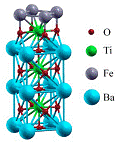Department of Physics and Astronomy: Publications and Other Research

Evgeny Tsymbal Publications
ORCID IDs
Li http://orcid.org/0000-0001-6967-4968
Xiao http://orcid.org/0000-0003-2461-2338
Chen http://orcid.org/0000-0002-3583-0149
Tsymbal http://orcid.org/0000-0002-6728-5480
Lu http://orcid.org/0000-0002-5942-1999
Hong http://orcid.org/0000-0002-7873-5774
Document Type
Article
Date of this Version
2020
Citation
Nature Communications (2020) 11: 1422
doi: 10.1038/s41467-020-15191-2
Supplementary materials are available at https://doi.org/10.1038/s41467- 020-15191-2
Abstract
Complex oxide heterointerfaces and van der Waals heterostructures present two versatile but intrinsically different platforms for exploring emergent quantum phenomena and designing new functionalities. The rich opportunity offered by the synergy between these two classes of materials, however, is yet to be charted. Here, we report an unconventional nonlinear optical filtering effect resulting from the interfacial polar alignment between monolayer MoS2 and a neighboring ferroelectric oxide thin film. The second harmonic generation response at the heterointerface is either substantially enhanced or almost entirely quenched by an underlying ferroelectric domain wall depending on its chirality, and can be further tailored by the polar domains. Unlike the extensively studied coupling mechanisms driven by charge, spin, and lattice, the interfacial tailoring effect is solely mediated by the polar symmetry, as well explained via our density functional theory calculations, pointing to a new material strategy for the functional design of nanoscale reconfigurable optical applications.


Comments
Copyright 2020, the authors. Open access
License: CC BY 4.0 International